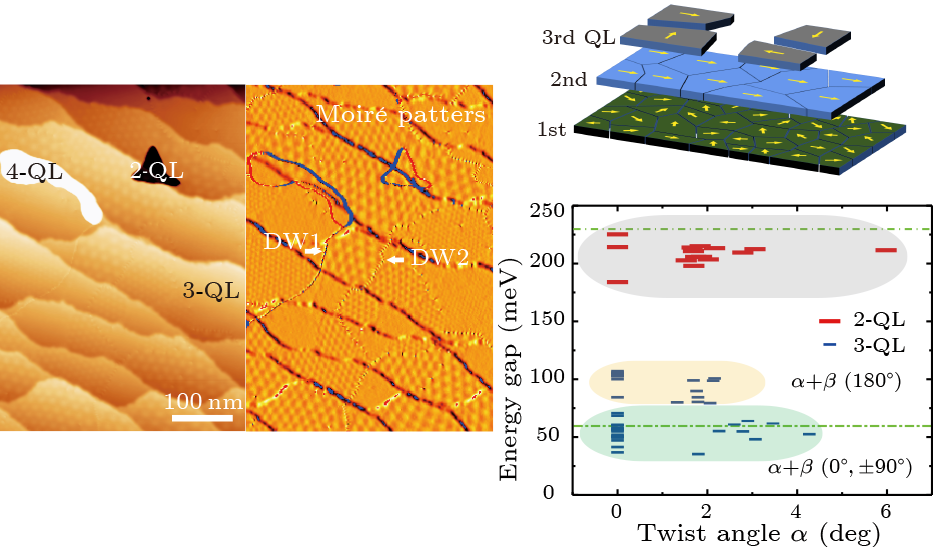| CONDENSED MATTER: ELECTRONIC STRUCTURE, ELECTRICAL, MAGNETIC, AND OPTICAL PROPERTIES |
 |
|

|
|
|
Modification of the Hybridization Gap by Twisted Stacking of Quintuple Layers in a Three-Dimensional Topological Insulator Thin Film |
| Changyuan Zhou , Dezhi Song , Yeping Jiang*, and Jun Zhang |
| Key Laboratory of Polar Materials and Devices, Department of Electronics, School of Physics and Electronic Science, East China Normal University, Shanghai 200241, China |
|
| Cite this article: |
|
Changyuan Zhou , Dezhi Song , Yeping Jiang et al 2021 Chin. Phys. Lett. 38 057307 |
|
|
|
|
Abstract Twisting the stacking of layered materials leads to rich new physics. A three-dimensional topological insulator film hosts two-dimensional gapless Dirac electrons on top and bottom surfaces, which, when the film is below some critical thickness, will hybridize and open a gap in the surface state structure. The hybridization gap can be tuned by various parameters such as film thickness and inversion symmetry, according to the literature. The three-dimensional strong topological insulator Bi(Sb)Se(Te) family has layered structures composed of quintuple layers (QLs) stacked together by van der Waals interaction. Here we successfully grow twistedly stacked Sb$_{2}$Te$_{3}$ QLs and investigate the effect of twist angels on the hybridization gaps below the thickness limit. It is found that the hybridization gap can be tuned for films of three QLs, which may lead to quantum spin Hall states. Signatures of gap-closing are found in 3-QL films. The successful in situ application of this approach opens a new route to search for exotic physics in topological insulators.
|
|
Received: 25 March 2021
Published: 10 April 2021

|
|
| PACS: |
73.20.At
|
(Surface states, band structure, electron density of states)
|
| |
68.37.Ef
|
(Scanning tunneling microscopy (including chemistry induced with STM))
|
| |
73.21.Cd
|
(Superlattices)
|
| |
68.65.Ac}
|
|
|
|
| Fund: Supported by the National Natural Science Foundation of China (Grant Nos. 61804056 and 92065102). |
|
|
|
| [1] | Hasan M Z and Kane C L 2010 Rev. Mod. Phys. 82 3045 |
| [2] | Chen Y L et al. 2009 Science 325 178 |
| [3] | Jiang Y et al. 2012 Phys. Rev. Lett. 108 016401 |
| [4] | Xia Y et al. 2009 Nat. Phys. 5 398 |
| [5] | Qi X L and Zhang S C 2011 Rev. Mod. Phys. 83 1057 |
| [6] | Zhang H, Liu C X, Qi X L, Dai X, Fang Z, and Zhang S C 2009 Nat. Phys. 5 438 |
| [7] | Fu L, Kane C L, and Mele E J 2007 Phys. Rev. Lett. 98 106803 |
| [8] | Zhang Y et al. 2010 Nat. Phys. 6 584 |
| [9] | Shan W Y, Lu H Z, and Shen S Q 2010 New J. Phys. 12 043048 |
| [10] | Liu C X, Zhang H, Yan B, Qi X L, Frauenheim T, Dai X, Fang Z, and Zhang S C 2010 Phys. Rev. B 81 041307 |
| [11] | Bernevig B A, Hughes T L, and Zhang S C 2006 Science 314 1757 |
| [12] | König M, Wiedmann S, Brüne C, Roth A, Buhmann H, Molenkamp L W, Qi X L, and Zhang S C 2007 Science 318 766 |
| [13] | Yang Y, Xu Z, Sheng L, Shen R, Wang B G, and Xing D Y 2012 Europhys. Lett. 100 27005 |
| [14] | Kim M, Kim C H, Kim H S, and Ihm J 2012 Proc. Natl. Acad. Sci. USA 109 671 |
| [15] | Murakami S, Iso S, Avishai Y, Onoda M, and Nagaosa N 2007 Phys. Rev. B 76 205304 |
| [16] | Cao Y, Fatemi V, Fang S, Watanabe K, Taniguchi T, Kaxiras E, and Jarillo-Herrero P 2018 Nature 556 43 |
| [17] | Jiang Y et al. 2012 Phys. Rev. Lett. 108 066809 |
| [18] | Wang G et al. 2011 Adv. Mater. 23 2929 |
| [19] | Song C L et al. 2010 Appl. Phys. Lett. 97 143118 |
| [20] | Zhang G et al. 2009 Appl. Phys. Lett. 95 053114 |
| [21] | Li Y Y et al. 2010 Adv. Mater. 22 4002 |
| [22] | Zhang T, Ha J, Levy N, Kuk Y, and Stroscio J 2013 Phys. Rev. Lett. 111 056803 |
|
|
Viewed |
|
|
|
Full text
|
|
|
|
|
Abstract
|
|
|
|
|